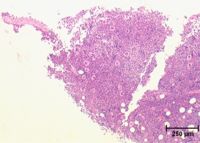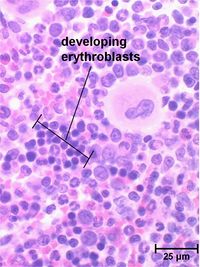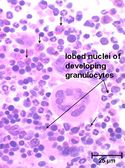Difference between revisions of "Bone Marrow"
| (44 intermediate revisions by 8 users not shown) | |||
| Line 1: | Line 1: | ||
| − | {{ | + | {{OpenPagesTop}} |
| − | | | + | [[Image:LH Bone Marrow 1 Histology.jpg|thumb|200px|'''Bone Marrow''' ©RVC 2008]] |
| − | + | ==Introduction== | |
| − | + | Bone marrow is referred to as [[#Red marrow|red]] or [[#Yellow marrow|yellow]]. Red bone marrow is involved with [[Haemostasis|haemostasis]] while yellow bone marrow is adipose tissue. Bone marrow occupies the cavities in [[Bones - Anatomy & Physiology#Types of Bone|long bones]] and spaces in [[Bones - Anatomy & Physiology#Lamellar bone|spongy bones]]. | |
| − | | | ||
| − | | | ||
| − | | | ||
| − | |||
| − | | | ||
| − | |||
| − | | | ||
| − | |||
| − | |||
| − | |||
==Development== | ==Development== | ||
| − | <p>Pluripotential haematopoietic stem cells (PPSC) migrate into bones from the embryonic yolk sac and the foetal liver during development, a process called homing. The cells then associate closely with the connective tissues within the bone. The PPSCs continue to constantly divide in the bone marrow with one daughter cell remaining a pluripotential stem cell and the other daughter cells | + | <p>Pluripotential haematopoietic stem cells (PPSC) migrate into bones from the [[Haematopoiesis - Overview#Yolk Sac Phase|embryonic yolk sac]] and the [[Haematopoiesis - Overview#Foetal|foetal liver]] during development, a process called homing. The cells then associate closely with the connective tissues within the bone. The PPSCs continue to constantly divide in the bone marrow with one daughter cell remaining a pluripotential stem cell and the other daughter cells developing into multipotential haematopoietic stem cells. The multipotential stem cells also constantly divide with some daughter cells remaining stem cells and the other daughter cells developing into blood cells ([[Haematopoiesis - Overview|haematopoiesis]]).</p> |
==Red marrow== | ==Red marrow== | ||
| − | <p>Red bone marrow consists of blood vessels, sinusoids and a | + | <p>Red bone marrow consists of [[Blood Vessels|blood vessels]], sinusoids and a network of haematopoietic cells. Sinusoids are vascular components with an endothelial layer, basal lamina and an outer adventitial cell layer. The adventitia cells are also called reticular cells and these extend into the haematopoietic cells in sheets to provide structural support. They also produce reticular fibres and [[Cytokines|cytokines]] to help stimulate blood cell production. Histological sections show that the haematopoietic cells lie in cords. The cells in these cords form many different blood cell types but cells producing one cell type tend to be located in groups along the cords.</p> |
| + | |||
==Yellow marrow== | ==Yellow marrow== | ||
<p>In young animals the majority of marrow is red. However as the animal matures into an adult significant portions of the haematopoietic tissues is replaced by adipose tissue. In adults all of the marrow in the long bones is adipose tissue and significant portions of marrow in haematopoietically active bones is adipose tissue as well.</p> | <p>In young animals the majority of marrow is red. However as the animal matures into an adult significant portions of the haematopoietic tissues is replaced by adipose tissue. In adults all of the marrow in the long bones is adipose tissue and significant portions of marrow in haematopoietically active bones is adipose tissue as well.</p> | ||
| + | |||
==Functions== | ==Functions== | ||
''Functions refer to red marrow'' | ''Functions refer to red marrow'' | ||
| + | |||
=== Haematopoietic=== | === Haematopoietic=== | ||
| − | <p>The haematopoietic cells produce the vast majority of blood cells in the body (haematopoiesis). In young animals this occurs in most bones in the body but in mature adults this is limited to membranous bones in the body.</p> | + | [[Image:LH Bone Marrow Erythroblasts Histology.jpg|thumb|200px|'''Developing erythrocytes''' ©RVC 2008]] |
| − | <p>To enter circulation newly formed cells press against the sinusoid wall, temporally fusing to it and creating an opening. The cell then passes directly into the circulation and the membrane repairs itself. Mature [[Erythrocytes | + | <p>The haematopoietic cells produce the vast majority of blood cells in the body ([[Haematopoiesis - Overview|haematopoiesis]]). In young animals this occurs in most bones in the body but in mature adults this is limited to membranous bones in the body.</p> |
| − | <p>[[Thrombopoiesis | + | <p>To enter circulation newly formed cells press against the sinusoid wall, temporally fusing to it and creating an opening. The cell then passes directly into the circulation and the membrane repairs itself. Mature [[Erythrocytes|erythrocytes]] immediately enter circulation, however the marrow stores [[Leukocytes|leukocytes]] and consequently contains around ten times more [[Leukocytes|leukocytes]] than found in circulation</p> |
| + | <p>[[Thrombopoiesis#Megakaryocyte|Megakaryocytes]] reside alongside the sinusoid membrane but do not leave the tissue, rather they release their [[Thrombocytes|platelets]] and then withdraw from the membrane.</p> | ||
| + | |||
===Lymphoid tissue=== | ===Lymphoid tissue=== | ||
| − | + | [[Image:LH Bone Marrow Granulocyte Histology.jpg|thumb|125px|'''Developing granulocytes''' ©RVC 2008]] | |
| − | + | In some primates bone marrow acts as a [[:Category:Primary Lymphoid Tissue|primary lymphoid organ]]. Bone marrow is also a [[:Category:Secondary Lymphoid Tissue|secondary lympoid tissue]] in other species. | |
| − | + | <p>It has little involvement in the primary immune response, but the migration of [[B cell differentiation#Memory cells|memory cells]] into the marrow from the [[Spleen - Anatomy & Physiology|spleen]] and [[Lymph Nodes - Anatomy & Physiology|lymph nodes]] means that during a subsequent exposure to an antigen it produces significant amounts of antibodies.</p> | |
| − | <p>It has little involvement in the primary immune response, but the migration of [[B cell differentiation | + | |
===Others=== | ===Others=== | ||
| − | + | Bone marrow is a significant source of antibodies as a large population of antibody-producing cells ([[B cell differentiation#Plasma cells|plasma cells]]) reside there. [[Macrophages|Macrophages]] and [[T cell differentiation#Dendritic Cells|dendritic cells]] in the marrow remove foreign substance from the blood, a process which also occurs in the [[Lymph Nodes - Anatomy & Physiology|lymph nodes]], [[Spleen - Anatomy & Physiology|spleen]] and [[Liver - Anatomy & Physiology#Functions|liver]]. | |
| − | + | ||
| − | + | {{Template:Learning | |
| + | |dragster = [[Blood Histology Resource (IV)|Bone Marrow Histology Dragster]] | ||
| + | }} | ||
| + | <br><br> | ||
| + | {{Jim Bee 2007}} | ||
| + | |||
| + | {{OpenPages}} | ||
| + | [[Category:Primary Lymphoid Tissue]] | ||
| + | [[Category:Bone and Cartilage - Anatomy & Physiology]] | ||
| + | [[Category:A&P Done]] | ||
Latest revision as of 19:16, 28 June 2012
Introduction
Bone marrow is referred to as red or yellow. Red bone marrow is involved with haemostasis while yellow bone marrow is adipose tissue. Bone marrow occupies the cavities in long bones and spaces in spongy bones.
Development
Pluripotential haematopoietic stem cells (PPSC) migrate into bones from the embryonic yolk sac and the foetal liver during development, a process called homing. The cells then associate closely with the connective tissues within the bone. The PPSCs continue to constantly divide in the bone marrow with one daughter cell remaining a pluripotential stem cell and the other daughter cells developing into multipotential haematopoietic stem cells. The multipotential stem cells also constantly divide with some daughter cells remaining stem cells and the other daughter cells developing into blood cells (haematopoiesis).
Red marrow
Red bone marrow consists of blood vessels, sinusoids and a network of haematopoietic cells. Sinusoids are vascular components with an endothelial layer, basal lamina and an outer adventitial cell layer. The adventitia cells are also called reticular cells and these extend into the haematopoietic cells in sheets to provide structural support. They also produce reticular fibres and cytokines to help stimulate blood cell production. Histological sections show that the haematopoietic cells lie in cords. The cells in these cords form many different blood cell types but cells producing one cell type tend to be located in groups along the cords.
Yellow marrow
In young animals the majority of marrow is red. However as the animal matures into an adult significant portions of the haematopoietic tissues is replaced by adipose tissue. In adults all of the marrow in the long bones is adipose tissue and significant portions of marrow in haematopoietically active bones is adipose tissue as well.
Functions
Functions refer to red marrow
Haematopoietic
The haematopoietic cells produce the vast majority of blood cells in the body (haematopoiesis). In young animals this occurs in most bones in the body but in mature adults this is limited to membranous bones in the body.
To enter circulation newly formed cells press against the sinusoid wall, temporally fusing to it and creating an opening. The cell then passes directly into the circulation and the membrane repairs itself. Mature erythrocytes immediately enter circulation, however the marrow stores leukocytes and consequently contains around ten times more leukocytes than found in circulation
Megakaryocytes reside alongside the sinusoid membrane but do not leave the tissue, rather they release their platelets and then withdraw from the membrane.
Lymphoid tissue
In some primates bone marrow acts as a primary lymphoid organ. Bone marrow is also a secondary lympoid tissue in other species.
It has little involvement in the primary immune response, but the migration of memory cells into the marrow from the spleen and lymph nodes means that during a subsequent exposure to an antigen it produces significant amounts of antibodies.
Others
Bone marrow is a significant source of antibodies as a large population of antibody-producing cells (plasma cells) reside there. Macrophages and dendritic cells in the marrow remove foreign substance from the blood, a process which also occurs in the lymph nodes, spleen and liver.
| Bone Marrow Learning Resources | |
|---|---|
 Test your knowledge using drag and drop boxes |
Bone Marrow Histology Dragster |
| Originally funded by the RVC Jim Bee Award 2007 |
Error in widget FBRecommend: unable to write file /var/www/wikivet.net/extensions/Widgets/compiled_templates/wrt67422599269778_53764668 Error in widget google+: unable to write file /var/www/wikivet.net/extensions/Widgets/compiled_templates/wrt674225992bc0e5_11001944 Error in widget TwitterTweet: unable to write file /var/www/wikivet.net/extensions/Widgets/compiled_templates/wrt67422599304341_25492534
|
| WikiVet® Introduction - Help WikiVet - Report a Problem |


